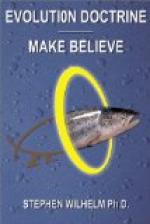The problems of physical evolution of man and of men fall into two groups. Those of the first deal with the origin of the human species as a unit, and its comparative relation to lower organisms, while those of the second part are concerned with the further evolution of human races that have come to be different in certain details of structure since the human type as such arose. In the first part, all men will be assumed to be alike and the members of a homogeneous species whose fundamental attributes are to be compared with those of other animals; only afterwards will attention be directed to the differences, previously ignored, that divide human beings into well-marked varieties. It must be evident even at this point that the mode of evolution demonstrated by the first investigation will be likely to bear some close relation to the methods by which human races have evolved to their present diverse anatomical situations.
* * * * *
The foregoing classification of the problems concerned with the nature and origin of the human species renders it possible to restrict the immediate inquiry to a definite and precise question. It is this: does the evidence relating to the physical characteristics of our species prove that man is the product of a supernatural act of creation, or does it show that man’s place in nature has been reached by a gradual process of natural evolution? In order to obtain an equally precise and definite answer to this question, referring to the particular case of most concern to us, it is obvious that the method to be employed is the one which has given us an understanding of organic evolution as an all-inclusive natural process. The data must be verified, related, and classified, so that their meaning may be concisely stated in the form of scientific principles. What are the facts of human structure, comparatively treated? How does the human body develop? Does palaeontology throw any light on the antiquity of man? Do the rules of nature’s order control the lives of men? Our course is now clear; we shall take up serially the anatomy, embryology, and fossil history of the human species, in order to see that there is ample proof of the actual occurrence of evolution, and then, as before, we may look about for the causes which have produced this result by natural methods.
While it is necessary to treat the subject directly, namely, by examining the actual evidences relating to the particular case in question, it is worthwhile before doing so to point out that, as the whole includes a part, human evolution has already been proved beyond question. This conclusion must be accepted, unless reasons can be given for excluding mankind from the rest of the living world as an absolutely unique type, supreme and isolated because of some peculiar endowments not shared with the rest of animate nature. If these reasons are lacking, and the unity of organic nature be recognized, human evolution cannot be denied unless some interpretation more reasonable and logical than evolution can be given for the whole mass of facts exemplified and discussed in the foregoing chapters. We may accordingly approach the main questions by asking if there are any reasons for regarding the human species as a unique and isolated type of organism.




